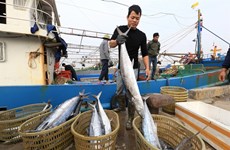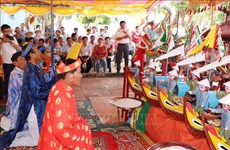Minority cultures worth preserving
Happily married with a little daughter in Dong Van Town, 500km north of
Hanoi , Trang Thi Lan, 30, misses her own people at festival times.
Happily married with a little daughter in Dong Van Town, 500km north of
Hanoi , Trang Thi Lan, 30, misses her own people at festival times.
She never forgets that she is part of about 600 Pu Peo people in Vietnam although she now follows the customs of the Tay , a far bigger ethnic group and also her husband's community.
"The ways the two ethic groups worship and perform ritual offerings are totally different. Unfortunately as a wife, I have to discard my customs and adopt his," said the kindergarten and first grade teacher.
It took her some time to get used to cutting boiled chicken into small pieces and putting it on plates at the altar as other Tay women do, instead of offering the whole boiled bird as in Pu Peo culture.
"And my daughter also has to follow her father's customs, making her more of a Tay than a Pu Peo. What a shame!" said rosy-faced Lan with a sigh.
Inter-ethnic marriages have become a new challenge threatening the identity of Pu Peo people, one of the five ethnic groups with a population of less than 1,000, after their living standards much increased thanks to the Government supports.
The Pu Peo, who live only in Ha Giang province, together with the Si La in Lai Chau and Dien Bien, O Du in Nghe An, Brau and Ro Mam both in Kon Tum, are the beneficiaries of the first Government programme to support the country's smallest ethnic groups. It ran from 2005 to 2010.
A total of 76.8 billion VND (3.65 million USD) was spent on building roads, irrigation works, schools, healthcare centres and power lines in these tribal areas. Locals were also trained in new farming techniques and given funds to ensure they hold onto their unique but fast fading festivals.
"This programme laid a firm ground for a better development of minority people," said Trinh Cong Khanh, head of the Policy Department under the State Committee for Ethnic Minority Affairs.
Giang My Giang, chairman of Ha Giang's Pho La Commune, where the biggest community of Pu Peo people lives, said life quality has greatly improved since the programme starts.
The new roads have opened up new trade opportunities and helped reduce the poverty rate - and all children are now sent to school where the youngest are still taught in their own language.
Chung Trai Village , home to 136 Pu Peo people, is now among the most developed areas in Pho La Commune, according to Giang.
Cung Phu Suan, head of the village, recognises the big changes that his people have seen since 2005.
"I'm really happy with all positive developments brought about by the Government's interest-free loan scheme and education supports," he said.
An ancient shamanistic tribute to the Forest God every July was revived with the help of the programme.
Like a dream come true, five Pu Peo teenagers were enrolled in universities between 2009 and 2011.
And best of all, marriages between cousins have been declining sharply, said Suan. "Most villagers no longer want this type of marriage since they have been told about the potential genetic dangers to the next generations."
One couple, Trang Thi Mai and her husband, Ly Te Ngan - her first cousin, worry about those dangers as their second son, now 14 looks no older than seven.
"I will never let my children do the same. It's no good!" said Ngan.
Director of Ha Giang's Ethnic Issues Department Long Vinh Phuc said the most important legacy of the Government's support scheme is better awareness about all aspects of life.
However, on the downside, this opening up to the wider world is putting the future of the Pu Peo as a distinct group at risk.
Cross-tribal marriages, movement to bigger towns and cities and smaller families are the new challenges facing the tribe, one of the oldest in the region.
Lan's decision to marry a Tay because every Pu Peo youth she knew was a relative - "and I did not want a cousin marriage," she said.
The latest census from Dong Van district's Ethnic Issues Department reveals that there have been 20 inter-ethnic marriages involving Pu Peo people in recent years. "That is something we never heard of 10 years ago," says Suan.
Higher education means young couples today tend to get married older and only want one or two children. Like many of her Pu Peo female friends, Lan is considering if she should have a second child. "I like children, but I don't think we can afford such a big family," she said.
According to Suan, the population of Chung Trai Village has risen by only six in the last seven years, despite Government encouragement for couples in these ethnic areas to have as many babies as they want.
From another perspective, traditional clothes are rarely seen in the Pu Peo village today. None of the five members in Mai and Ngan's family has any traditional costumes, since, like mainstream Vietnamese, they prefer popular clothes for convenience.
"We can't buy traditional costumes. We have to make them ourselves. It takes a lot of effort, but it's so much easier and cheaper to buy ready-made clothes," said Mai.
Dinh My Thao, deputy head of Dong Van district's Ethnic Issues Department, admits it is hard to address these new challenges. "That's the other side of the coin [development process] we have to accept."
According to him, Pu Peo people must assimilate with other ethnic groups to achieve a better quality of population. "But it's sadly means the degradation in their cultural identity," he said.
For Thao, the only way to help the remaining 600 people is more State investment to preserve their culture. For instance, he suggested the State might have to pay artisans to make traditional customs for everyone.
The other four smallest ethnic groups in the country, Si La, O Du, Brau and Ro Mam, are also facing similar challenges, said policy department chief Khanh. But most of the Government support for the five groups with a population under 1,000 ended a year ago, apart from some preferential policies in education and training and credit schemes.
"There are still many other small ethnic groups that need help. It's now time for them," said Khanh.
Prime Minister Nguyen Tan Dung recently approved a 10-year programme costing 1,042 billion VND (49.6 million USD) to support five other ethnic groups with populations of less than 5,000 – Mang, La Hu, Cong and Co Lao, all in the northern mountains.
According to the State Committee for Ethnic Minority Affairs, the poverty rate in these groups is expected to be cut from 78 percent to 60 percent in the next four years. Malnutrition among children under five is expected to be cut to 30 percent.
The committee has also proposed another programme that, if approved, will extend supports to seven ethnic groups of less than 10,000 people.
"Infrastructure, production, education and health are the most important parts of our supporting schemes," says Khanh.
He said he hopes the minorities will be able to address cultural issues on their own in the future, when they no longer have to worry about making ends meet.
"When their societies are developed enough, hopefully they will get back to their traditional values and treasure their own identity," he said./.
She never forgets that she is part of about 600 Pu Peo people in Vietnam although she now follows the customs of the Tay , a far bigger ethnic group and also her husband's community.
"The ways the two ethic groups worship and perform ritual offerings are totally different. Unfortunately as a wife, I have to discard my customs and adopt his," said the kindergarten and first grade teacher.
It took her some time to get used to cutting boiled chicken into small pieces and putting it on plates at the altar as other Tay women do, instead of offering the whole boiled bird as in Pu Peo culture.
"And my daughter also has to follow her father's customs, making her more of a Tay than a Pu Peo. What a shame!" said rosy-faced Lan with a sigh.
Inter-ethnic marriages have become a new challenge threatening the identity of Pu Peo people, one of the five ethnic groups with a population of less than 1,000, after their living standards much increased thanks to the Government supports.
The Pu Peo, who live only in Ha Giang province, together with the Si La in Lai Chau and Dien Bien, O Du in Nghe An, Brau and Ro Mam both in Kon Tum, are the beneficiaries of the first Government programme to support the country's smallest ethnic groups. It ran from 2005 to 2010.
A total of 76.8 billion VND (3.65 million USD) was spent on building roads, irrigation works, schools, healthcare centres and power lines in these tribal areas. Locals were also trained in new farming techniques and given funds to ensure they hold onto their unique but fast fading festivals.
"This programme laid a firm ground for a better development of minority people," said Trinh Cong Khanh, head of the Policy Department under the State Committee for Ethnic Minority Affairs.
Giang My Giang, chairman of Ha Giang's Pho La Commune, where the biggest community of Pu Peo people lives, said life quality has greatly improved since the programme starts.
The new roads have opened up new trade opportunities and helped reduce the poverty rate - and all children are now sent to school where the youngest are still taught in their own language.
Chung Trai Village , home to 136 Pu Peo people, is now among the most developed areas in Pho La Commune, according to Giang.
Cung Phu Suan, head of the village, recognises the big changes that his people have seen since 2005.
"I'm really happy with all positive developments brought about by the Government's interest-free loan scheme and education supports," he said.
An ancient shamanistic tribute to the Forest God every July was revived with the help of the programme.
Like a dream come true, five Pu Peo teenagers were enrolled in universities between 2009 and 2011.
And best of all, marriages between cousins have been declining sharply, said Suan. "Most villagers no longer want this type of marriage since they have been told about the potential genetic dangers to the next generations."
One couple, Trang Thi Mai and her husband, Ly Te Ngan - her first cousin, worry about those dangers as their second son, now 14 looks no older than seven.
"I will never let my children do the same. It's no good!" said Ngan.
Director of Ha Giang's Ethnic Issues Department Long Vinh Phuc said the most important legacy of the Government's support scheme is better awareness about all aspects of life.
However, on the downside, this opening up to the wider world is putting the future of the Pu Peo as a distinct group at risk.
Cross-tribal marriages, movement to bigger towns and cities and smaller families are the new challenges facing the tribe, one of the oldest in the region.
Lan's decision to marry a Tay because every Pu Peo youth she knew was a relative - "and I did not want a cousin marriage," she said.
The latest census from Dong Van district's Ethnic Issues Department reveals that there have been 20 inter-ethnic marriages involving Pu Peo people in recent years. "That is something we never heard of 10 years ago," says Suan.
Higher education means young couples today tend to get married older and only want one or two children. Like many of her Pu Peo female friends, Lan is considering if she should have a second child. "I like children, but I don't think we can afford such a big family," she said.
According to Suan, the population of Chung Trai Village has risen by only six in the last seven years, despite Government encouragement for couples in these ethnic areas to have as many babies as they want.
From another perspective, traditional clothes are rarely seen in the Pu Peo village today. None of the five members in Mai and Ngan's family has any traditional costumes, since, like mainstream Vietnamese, they prefer popular clothes for convenience.
"We can't buy traditional costumes. We have to make them ourselves. It takes a lot of effort, but it's so much easier and cheaper to buy ready-made clothes," said Mai.
Dinh My Thao, deputy head of Dong Van district's Ethnic Issues Department, admits it is hard to address these new challenges. "That's the other side of the coin [development process] we have to accept."
According to him, Pu Peo people must assimilate with other ethnic groups to achieve a better quality of population. "But it's sadly means the degradation in their cultural identity," he said.
For Thao, the only way to help the remaining 600 people is more State investment to preserve their culture. For instance, he suggested the State might have to pay artisans to make traditional customs for everyone.
The other four smallest ethnic groups in the country, Si La, O Du, Brau and Ro Mam, are also facing similar challenges, said policy department chief Khanh. But most of the Government support for the five groups with a population under 1,000 ended a year ago, apart from some preferential policies in education and training and credit schemes.
"There are still many other small ethnic groups that need help. It's now time for them," said Khanh.
Prime Minister Nguyen Tan Dung recently approved a 10-year programme costing 1,042 billion VND (49.6 million USD) to support five other ethnic groups with populations of less than 5,000 – Mang, La Hu, Cong and Co Lao, all in the northern mountains.
According to the State Committee for Ethnic Minority Affairs, the poverty rate in these groups is expected to be cut from 78 percent to 60 percent in the next four years. Malnutrition among children under five is expected to be cut to 30 percent.
The committee has also proposed another programme that, if approved, will extend supports to seven ethnic groups of less than 10,000 people.
"Infrastructure, production, education and health are the most important parts of our supporting schemes," says Khanh.
He said he hopes the minorities will be able to address cultural issues on their own in the future, when they no longer have to worry about making ends meet.
"When their societies are developed enough, hopefully they will get back to their traditional values and treasure their own identity," he said./.












